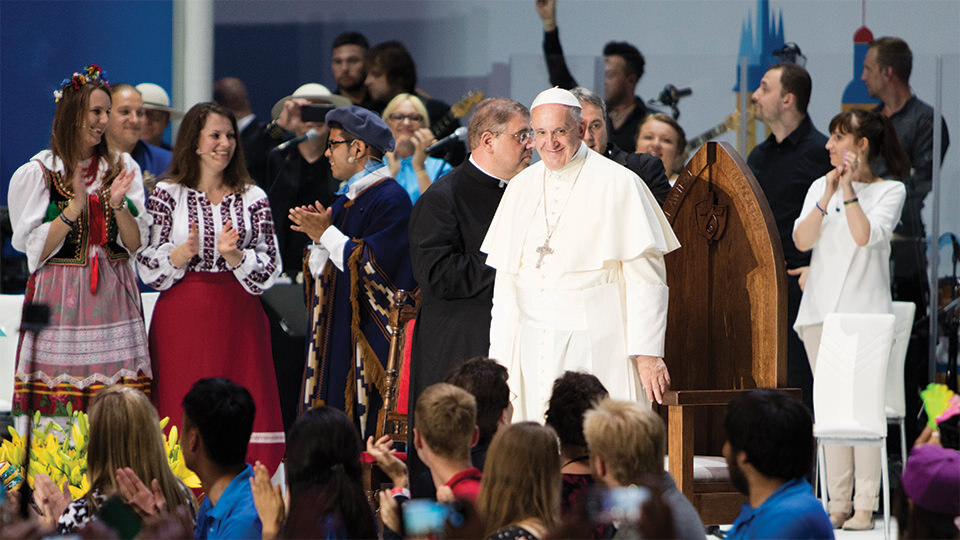Pope Francis' Synodal Legacy
Matthew Neugebauer
Thursday, March 9, 2023

Pope Francis greets youth during the World Youth Day in Krakow, Poland 2016 © Salt + Light Media
What is the "Pope Francis legacy?" Ten years in, we can start asking the question. After three encyclicals, 40 Apostolic Journeys (his 41st, to Hungary, was just announced!), countless speeches, addresses, letters, homilies, and audiences, we can explore what it all might amount to. Then there are poignant gestures: vacating the Apostolic Palace in favour of living simply in community with others at the Casa Santa Marta; kissing the feet of South Sudanese leaders in the name of peace; offered Eucharistic Adoration on behalf of the human family engulfed in a pandemic, and multiple off-the-cuff comments that beckon further elaboration (“who am I to judge him?” “Every time a woman comes in to do a job in the Vatican, things get better.”) How will history remember the first pope from the Global South, the first Jesuit pope, and the first pope to take the hallowed name of the monk of Assisi?
I can't help but wonder if the most important, most influential chapter is only now being written. Julian offered an excellent reflection on the way Pope Francis has sought to embody what he calls the “style of God”: closeness, tenderness, compassion, and joy. What will the practical, structural, long-term impact of this style be on the Church? I can ask again–what are all his messages and gestures building towards?
Over this decade of gestures and moments, a distinct pattern of large-scale governance has stood out. When Pope Francis knew that the Church in a particular region or a particular segment needed to find specific, sensitive responses to their unique challenges, he would employ the very tool that Paul VI restored during Vatican II for the Latin Church: regular synods, mainly comprised of bishops with the input of others. A synod on youth, a synod on the family, a synod on the Amazon. All of them were tasked with learning more deeply the everyday circumstances that people face, and developing creative ideas to support vital ministries in those aspects of the Universal Church.
Then in March 2020, he made an announcement that may well define his papacy: a synod on synodality itself. The hope would be for this next synod to carry the momentum of the past few decades of the institution’s history and expand beyond its piecemeal approach. In his Opening Address a year later, he said that this “Synod on Synodality” was an opportunity to move “not occasionally but structurally towards a synodal Church, an open square where all can feel at home and participate.” This time, the synod wouldn't be about addressing a specific issue or set of issues, but about orienting the whole Church towards the bonds of communion and the centrifugal energy of mission by "enlarging the tent" of active participation.
The tent would be enlarged, the Church would be re-oriented, if it took a pause from everyday affairs, started to listen more. As he continued in his Opening Address:
The Synod offers us the opportunity to become a listening Church. To listen to the Spirit in adoration and prayer. To listen to our brothers and sisters speak of their hopes and of the crises of faith present in different parts of the world, of the need for a renewed pastoral life and of the signals we are receiving from those on the ground.For many, the local consultations of the Diocesan Phase demonstrated that the Synod on Synodality was beginning to make the most of this opportunity on behalf of the Church. As the Working Document for the Continental Stage (the summary of the Diocesan Phase) notes, “Widespread appreciation was given to the method of spiritual conversation. […]Many [participants] emphasized that this was the first time the Church had asked for their opinion.” (#17) While previous synods under Pope Francis ensured that married couples, young people, and a cross-section of inhabitants of the Amazon had direct involvement in their respective consultations, the scale of the Diocesan Phase clearly introduced a new experience for many. The local and regional consultations of the Diocesan and Continental Stages from 2021 to 2023 provided a profound opportunity for Church leaders to come close to “those on the ground,” and show God’s tenderness and compassion through listening. For Pope Francis, this practice of synodality is what it means for the Church to express the “style of God.” On this point, I’ll quote his Opening Address again, at length:
Let us keep going back to God’s own “style,” which is closeness, compassion and tender love. God has always operated that way. If we do not become this Church of closeness with attitudes of compassion and tender love, we will not be the Lord’s Church. Not only with words, but by a presence that can weave greater bonds of friendship with society and the world. A Church that does not stand aloof from life, but immerses herself in today’s problems and needs, bandaging wounds and healing broken hearts with the balm of God. Let us not forget God’s style, which must help us: closeness, compassion and tender love. (Emphasis added.)So, what does this have to do with the pope’s legacy? Veteran Vatican reporter John Allen, while commenting on the announcement that the synod process would be extended to 2024, didn't downplay just how important the endeavour could be to the whole Francis papacy. He called it a “peak moment” of the pontificate, and argued that the pope himself sees the growth of synodality as “the imprint that he is trying to leave upon the Catholic Church.” In short, Pope Francis hopes that this is his legacy. It’s his Big Swing, his big task, what everything else he’s done is building towards, now compressed into a four-year period and culminating in two formal sessions in October 2023 and 2024. For Pope Francis, the Synod on Synodality isn't simply about finding specific solutions, but about the very identity of the Church itself. For the pope, synodality–the way together–is at the heart of what the Church is and what he dreams it to be:
If we understand that ‘Church and Synod are synonymous’ (St. John Chrysostom, Explicatio in Ps. 149), inasmuch as the Church is nothing other than the ‘journeying together’ of God’s flock along the paths of history towards the encounter with Christ the Lord, then we understand too that, within the Church, no one can be ‘raised up’ higher than others. On the contrary, in the Church, it is necessary that each person ‘lower’ himself or herself, so as to serve our brothers and sisters along the way. (Address Commemorating the 50th Anniversary of the Synod of Bishops, October 17, 2015)Pope Francis hopes to reorient the glimmering web of relationships within and beyond the Church. He hopes that all Catholics together can hear the Holy Spirit’s call for the Church to show God’s style of closeness, tenderness, and compassion in the world. He sees the Synod on Synodality as the most profound and lasting possibility in his pontificate for the Holy Spirit to empower the Church to become “a presence that can weave greater bonds of friendship with society and the world,” by first weaving those greater bonds among members of the Church. If he succeeds, the impact could last generations.
Related Articles:
>>
SUPPORT LABEL
$50
$100
$150
$250
OTHER AMOUNT
DONATE
Receive our newsletters
Stay Connected
Receive our newsletters

Stay Connected












